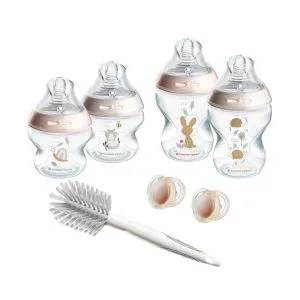Many breastfeeding new parents worry about their milk supply at some point in their feeding journey, you're not alone! It can be reassuring to know that it's rare for there to be a problem with your milk supply. If your baby is content, going through enough wet and dirty nappies for their age, and they're gaining weight and growing healthily, there shouldn't be any need for you to worry.
Babies who are breastfed are intuitive and take as much milk as they need during feed. And (providing that you don't have any medical issues) your boobs will automatically make the right amount of milk to meet their demand.
Tips to boost your breast milk supply
If you're looking for ways to increase the amount of breast milk you produce, we've pulled together some tips and techniques for you to try.
Seek breastfeeding support
First and foremost, if you're worried about anything to do with breastfeeding your baby, it's important that you consult your midwife, doctor or a lactation consultant before you make any changes to how you feed your little one. Talk to them for advice and support.
Certain conditions and medications can impact your breast milk supply, but with the help of a professional, you can ensure that your little one is getting all the nourishment they need!
Breastfeed regularly
When you're breastfeeding, the usual rule of thumb is that the more you feed, the more milk your body produces. Think supply and demand! When you increase the frequency and regularity that you empty your boobs, you send a signal to your body that it needs to produce more milk.
Practice skin-to-skin contact
Keeping your baby snuggled into your chest stimulates your milk-producing hormone. So, when you breastfeed your little one, try maintaining skin-to-skin contact to increase your milk supply.
Let baby take the lead
Keeping an eye out for your baby's hunger cues can help you to feed them before they get overly hungry. Paced feeding means more frequent feeds, and therefore more milk production.
Check your breastfeeding latch
When you achieve a comfortable breastfeeding latch, you'll be able to feed more often and for longer, so your body will produce more milk.
Feed from both breasts
When you're breastfeeding, let your baby finish on one side first, then offer the other side. You can also try 'switch nursing', which is the term used to describe switching back and forth between each breast multiple times during a feeding. These techniques help encourage a sleepy or distracted baby to feed for a little longer, and therefore helps boost your milk supply.
Express breast milk by hand or using a breast pump
Frequently and regularly expressing your breast milk with a breast pump and popping it into storage to feed to your baby in the future will boost your milk supply. Ultimately, it will also decrease the amount of time you spend pumping over time.
You can also try to schedule a pumping session straight after you're done breastfeeding. This can help if your boobs don't feel totally empty after a feed, as it stimulates your body to produce more breast milk and start increasing your milk supply.
Avoid using a dummy if possible
Using a dummy during your baby's first month can impact the production of breast milk. So, it's best to wait until you've established a good breastfeeding routine and are both feeling confident with breastfeeding before you introduce a soother.
If you do use a soother and you're worried about the impact it may have on your breast milk supply, choose one with a breast-like teat to avoid nipple confusion.
If possible, avoid supplementing with formula
The NHS states that topping up your feeds with formula milk will mean your baby will want to feed less. As a result of these reduced number of feeds, your breasts will start producing less milk. So, if you're wanting to boost your milk production levels, avoid giving your baby anything other than breast milk while you're breastfeeding. It can be difficult but try to persevere and remember that the more you breastfeed your baby, the more milk you'll produce. If you do want to top up their feeds with formula, wait until you have a good breastfeeding routine established.
Don't wean until they're ready
Waiting until your mini-me is ready to wean and move onto solids - usually around six months of age - can help maintain your breast milk supply.
Eat foods that help increase milk supply
Eating a balanced diet and staying hydrated can really help to maintain your breast milk supply. Certain foods that are high in vitamins and minerals can even aid in breast milk production. These foods are known as 'lactogenic' and include...
- Grains: Oats, cornmeal, barley like porridge or other oat-based cereals.
- Nuts and seeds: Sesame, pumpkin, sunflower seeds, and almonds.
- Fruits and vegetables: All fruit and veggies are great and healthy, but mushrooms, broccoli, asparagus, potatoes, and lettuce are said to be lactogenic. Peaches, nectarines, apricots, and cherries can also help!
- Water: Drinking enough liquids - at least six to eight glasses of water a day - to stay hydrated is important when you're breastfeeding. It's thirsty work! So when you settle down for a feed, keep a glass or bottle of water close by.
Be kind to yourself
No matter where you are in your breastfeeding journey, it's important to treat yourself with compassion and don't put too much pressure on yourself. Remember that as long as you do what's best for you and your little one, you're doing the right thing.


 £59.99 RRP: £64.99
£59.99 RRP: £64.99 £229.99 RRP: £349.99
£229.99 RRP: £349.99









